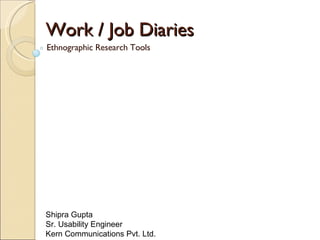Work Diaries
- 1. Work / Job Diaries Ethnographic Research Tools Shipra Gupta Sr. Usability Engineer Kern Communications Pvt. Ltd.
- 2. Method Job Diary is an ethnographic research method used in the ârequirements gatheringâ stage of UCD process in which the participant records all his activities in a log book ideally for a week and shares it with the research team
- 3. Pre-requisites A few things that the researcher needs to take care before he conducts Job shadowing: He needs to set clear goals and objectives of the study Should be aware of the ethnographic technique A template (diary) which will be given to the participant Identification of the right set of users Identification of the right set of users is very crucial for the study. The researcher needs to have a clear profile of the target users.
- 4. Format This is can be simple word documents or paper-based template, which the participant updates all through his day. The IA of the template is essentially divided into activities performed and physical environment, which takes care that the researcher takes quick and organized notes. The information required to capture is chunked as: Location Time â start and end time of a task Activity and sub activities Was it a group activity or independent Special Comments If any attachments â pictures/videos etc
- 5. Process - Checklist Identify the user Seek their availability Brief the user about the process and his role clearly Fix the period for which they will fill the diaries Analyze the samples Get back to the participant if any clarifications are required
- 6. Analyze the Diaries After receiving the diary from the user, the researcher should analyze the sample to map to the goals and objectives he had set before launching the study. Look out for emerging patterns and make the requirement list and other unseen needs that emerges from the diaries.
- 7. Advantages The researcher need not be present at the users location. Be a part of the users physical work environment and study its effects on the users behavior The user can fill the diary in the breaks and carry his routine without any disturbances Identify the unidentified needs The study is open ended, thus has a broader scope of understanding the users needs The observation made at this stage can come of help at a later stage of design process, for its been open ended and the captured data can be of help to the designer to understand the users behavior and needs at any stage of the design process. This helps in designing appropriate user profiles and scenarios.
- 8. Disadvantages The motivations of the user has to be really very high for him to carefully note all his activities regularly Self-reported data is always suspect Even best-intentioned participants have uneven memories Participants tend to draw conclusions rather than report experiences
- 9. Deliverables User information User needs Scenarios New Product Ideas








